What are the Syllable Division Rules
Whether you’re a language learner or a teacher, understanding how to divide words into syllables is incredibly useful. Syllable division is more than just a learning for the sake of it, it is essential for spelling, reading and the rhythm of speech.
Syllable division rules in English include the Vowel-Consonant-Vowel (VCV) rule, Consonant Blend/Digraph Rule, Prefix/Suffix Rule, Double Consonant Rule, ‘-le’ Ending Rule, R-Controlled Vowels Rule, Vowel Digraphs/Diphthongs Rule, Compound Word Rule, and Foreign Words Rule.
In this guide, we will explore the more common and some of the rarer ways we can divide syllables and we have printable examples you can use in class and home!
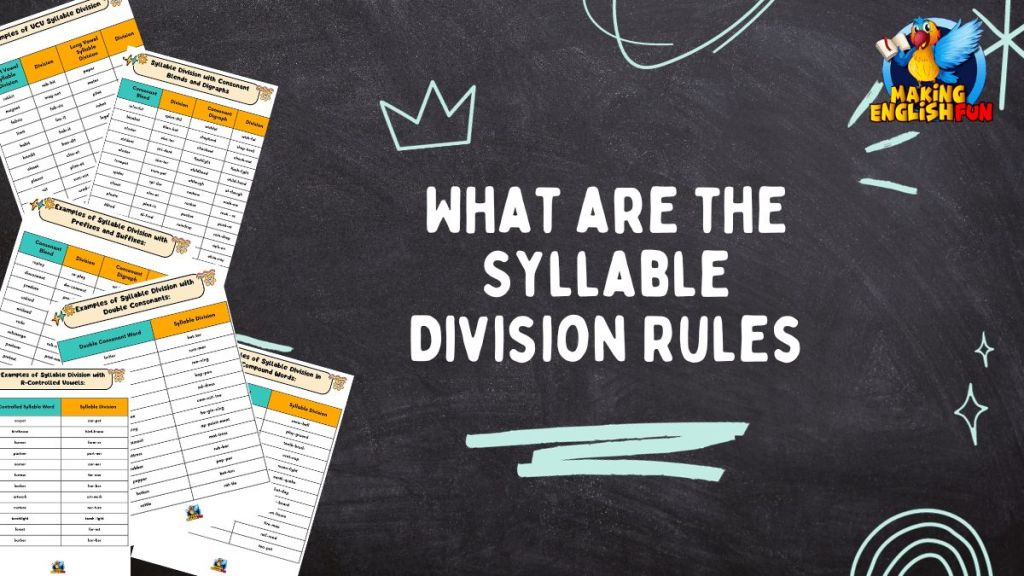
Understanding Syllables: The Building Blocks of Words
Syllables are the beats that make up words in spoken language. They form the foundation of pronunciation, influencing how we articulate and comprehend words.
Each syllable typically contains a vowel sound and often includes surrounding consonants.
Understanding syllables is not just about breaking words into smaller parts; it’s about grasping the rhythm and flow of language.
The role of syllables although very important in pronunciation also has an impact in spelling, reading, and writing.
- In reading, syllable awareness aids in decoding new words,
- while in writing, it assists in accurate spelling.
- Syllables also play a significant role in poetry and music, where the rhythm and meter are essential.
10 Syllable Division Rules.
We have listed and explained and even proved a printable tables for 10 of the syllable division rules in English below, though there are more. We thought these were the most common and the most likely to actually need teaching explicitly to some degree.
1. Vowel-Consonant-Vowel (VCV) Rule
The Vowel-Consonant-Vowel, or VCV, rule is concerned with how to divide words when they have a sequence of a vowel followed by a consonant and then another vowel.
The division of the syllable largely depends on the type of the first vowel – whether it’s a short or a long vowel.
In cases where the first vowel is short, the syllable tends to break before the consonant sound, effectively closing the first syllable with the consonant. This division is crucial for keeping that short vowel sound.
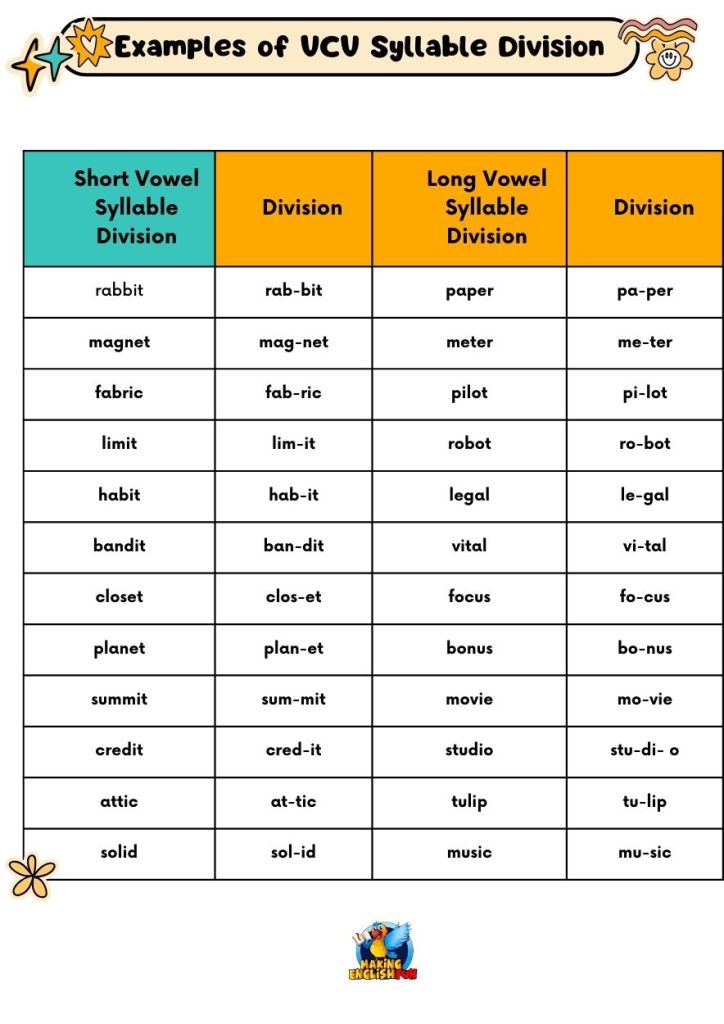
You can download this table from the link below.
Examples include words like “magnet” where the division is “mag-net.”
When the first vowel is long, the syllable often breaks after the consonant, leaving the consonant to start the next syllable.
This structure helps in preserving the long vowel sound.
An example of this can be seen in words like “paper,” where the division is “pa-per.”
The VCV rule is not just a phonetic guide but also influences spelling and pronunciation.
Table of Examples of VCV Syllable Division:
| Short Vowel Example | Division | Long Vowel Example | Division |
|---|---|---|---|
| rabbit | rab-bit | paper | pa-per |
| magnet | mag-net | meter | me-ter |
| fabric | fab-ric | pilot | pi-lot |
| limit | lim-it | robot | ro-bot |
| habit | hab-it | legal | le-gal |
| bandit | ban-dit | vital | vi-tal |
| closet | clos-et | focus | fo-cus |
| planet | plan-et | bonus | bo-nus |
| summit | sum-mit | movie | mo-vie |
| credit | cred-it | studio | stu-di- o |
| attic | at-tic | tulip | tu-lip |
| solid | sol-id | music | mu-sic |
2. Consonant Blend and Digraph Rule
In English, consonant blends and digraphs significantly influence syllable division.
- A consonant blend is a group of two or more consonants sounded together, where each consonant retains its sound, such as “bl” in “blank” or “str” in “street.”
- A digraph, on the other hand, consists of two consonants that together make a single sound, like “sh” in “shell” or “ch” in “chop.”
When dividing syllables in words with consonant blends or digraphs, the division typically happens keeping the blend or digraph intact.
This means we don’t split the sounds that are meant to be heard together.
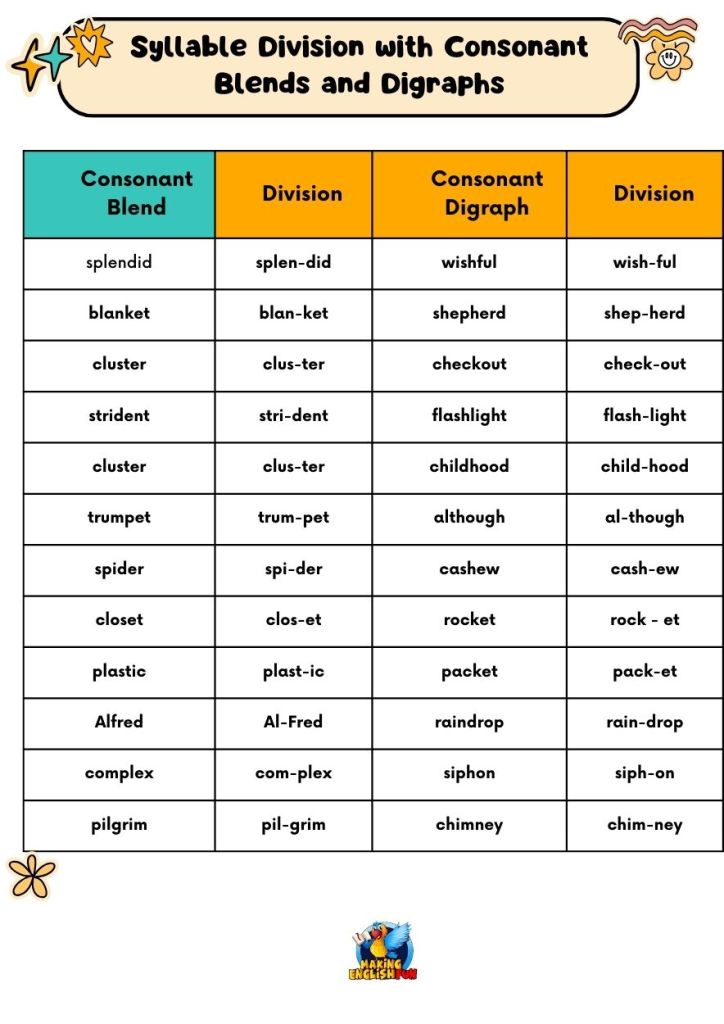
You can download and print this table from the link below.
For example, in “splendid,” we divide it as “splen-did,” keeping the blend “spl” together.
In the case of digraphs, like “wishful,” we divide it as “wish-ful,” ensuring the “sh” sound is not separated.
This rule helps maintain the phonetic integrity of the word, ensuring that the sounds meant to be heard together are not awkwardly divided.
Table of Examples of Syllable Division with Consonant Blends and Digraphs:
| Consonant Blend | Division | Digraph | Division |
|---|---|---|---|
| splendid | splen-did | wishful | wish-ful |
| blanket | blan-ket | shepherd | shep-herd |
| cluster | clus-ter | checkout | check-out |
| strident | stri-dent | flashlight | flash-light |
| cluster | clus-ter | childhood | child-hood |
| trumpet | trum-pet | although | al-though |
| spider | spi-der | cashew | cash-ew |
| closet | clos-et | rocket | rock – et |
| plastic | plast-ic | packet | pack-et |
| Alfred | Al-Fred | raindrop | rain-drop |
| complex | com-plex | siphon | siph-on |
| pilgrim | pil-grim | chimney | chim-ney |
3. Prefix and Suffix Rule
Prefixes and suffixes in English play an important role in syllable division.
A prefix is a group of letters added to the beginning of a word, and a suffix is added to the end. When dividing syllables, we usually separate the prefixes and suffixes from the root word.
For instance, “replay” is divided into “re-play,” which helps in identifying “re-” as a prefix meaning “again.”
Similarly, in “hopeful,” divided as “hope-ful,” the suffix “-ful” suggests the meaning of “full of.”
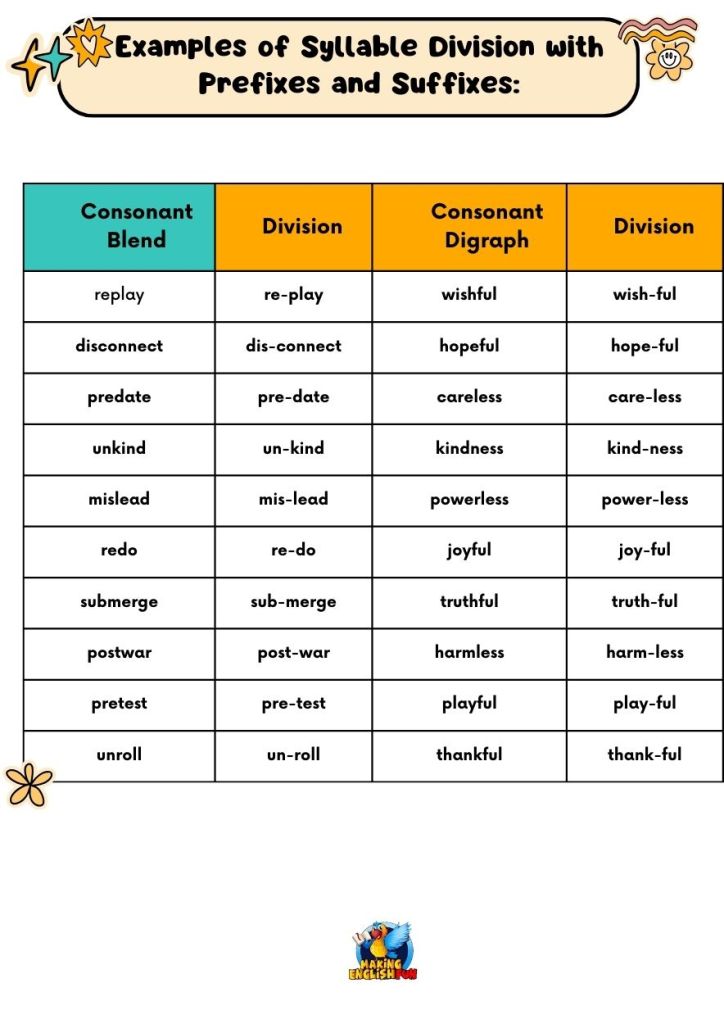
You can download this table from the link below.
Keeping prefixes and suffixes separate in syllable division also aids in spelling and comprehension.
Table of Examples of Syllable Division with Prefixes and Suffixes:
| Word with Prefix | Division | Word with Suffix | Division |
|---|---|---|---|
| replay | re-play | hopeful | hope-ful |
| disconnect | dis-connect | careless | care-less |
| predate | pre-date | kindness | kind-ness |
| unkind | un-kind | powerless | power-less |
| mislead | mis-lead | joyful | joy-ful |
| redo | re-do | truthful | truth-ful |
| submerge | sub-merge | harmless | harm-less |
| postwar | post-war | playful | play-ful |
| pretest | pre-test | fearless | fear-less |
| unroll | un-roll | thankful | thank-ful |
4. Double Consonant Rule
The Double Consonant Rule in English is straightforward yet crucial.
When a word contains double consonants, like “tt” in “butter” or “mm” in “summer,” the syllable division usually occurs between these consonants, and is also explained in the VCV Syllable rule above.
This division is important because it often signifies a short vowel sound preceding the double consonants.
In “butter,” dividing it as “but-ter” maintains the short “u” sound.
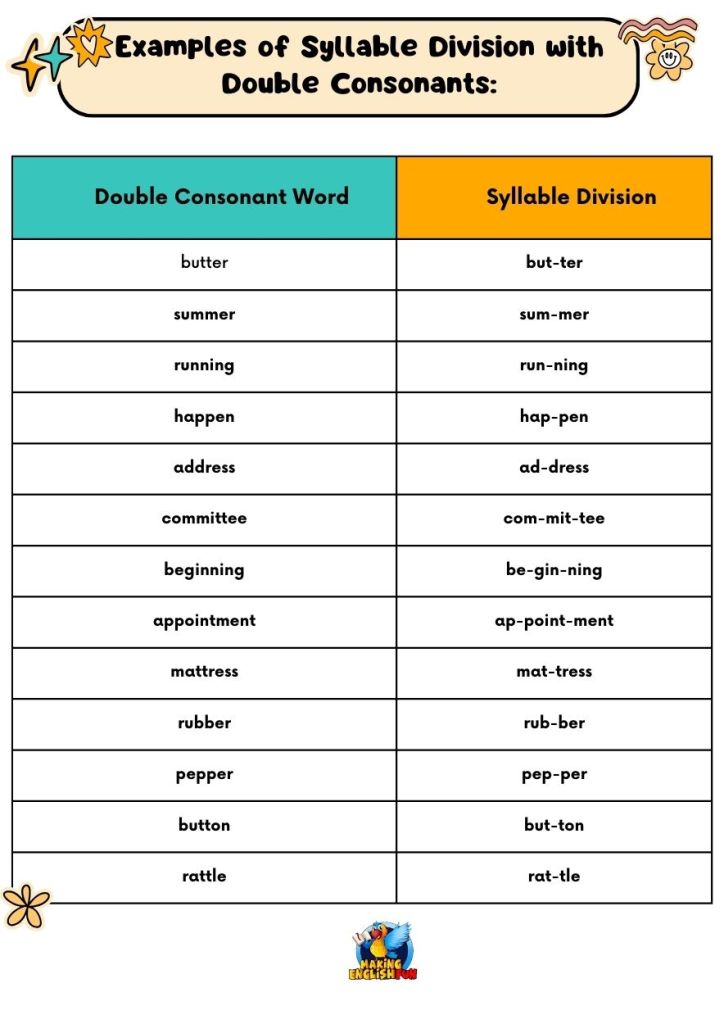
You can print and download this table from the link below.
This rule helps in clearly delineating the structure of the word, making it easier to pronounce and understand.
The presence of double consonants can also signal grammatical changes, as seen in words like “run” becoming “running.”
Table of Examples of Syllable Division with Double Consonants:
| Word | Division |
|---|---|
| butter | but-ter |
| summer | sum-mer |
| running | run-ning |
| happen | hap-pen |
| address | ad-dress |
| committee | com-mit-tee |
| beginning | be-gin-ning |
| appointment | ap-point-ment |
| mattress | mat-tress |
| rubber | rub-ber |
| pepper | pep-per |
| button | but-ton |
| rattle | rat-tle |
5. ‘le’ Syllable Rule
The ‘le’ rule in English syllable division applies to words ending in “-le.”
In such cases, the syllable generally begins with the consonant that precedes the “-le.”
This division is crucial for maintaining the characteristic sound of the “-le” ending, as in “bub-ble” or “cast-le.”
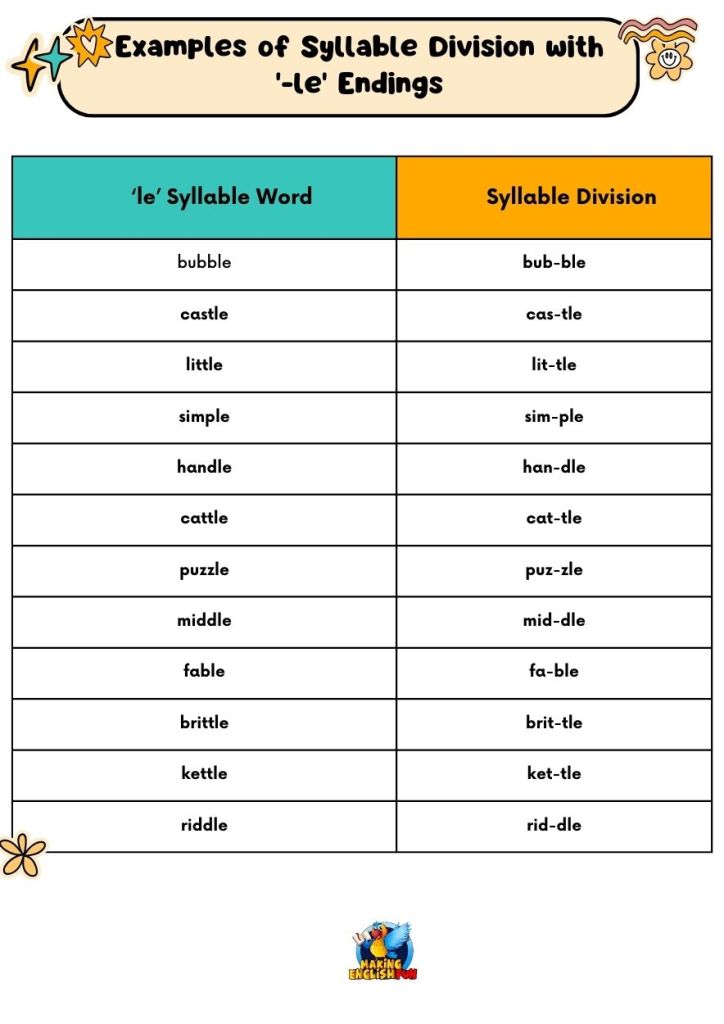
You can see this ta-ble, below and download a printable copy on the link under as well.
The consonant before the “-le” lends a distinct closure to the word, often creating a soft, muted sound that is common in these word endings.
Table of Examples of Syllable Division with ‘-le’ Endings:
| Word | Division |
|---|---|
| bubble | bub-ble |
| castle | cas-tle |
| little | lit-tle |
| simple | sim-ple |
| handle | han-dle |
| cattle | cat-tle |
| puzzle | puz-zle |
| middle | mid-dle |
| fable | fa-ble |
| brittle | brit-tle |
| kettle | ket-tle |
| riddle | rid-dle |
6. R-Controlled Vowels Rule
R-controlled vowels occur in English when a vowel is followed by an “r,” resulting in a unique sound that is neither long nor short.
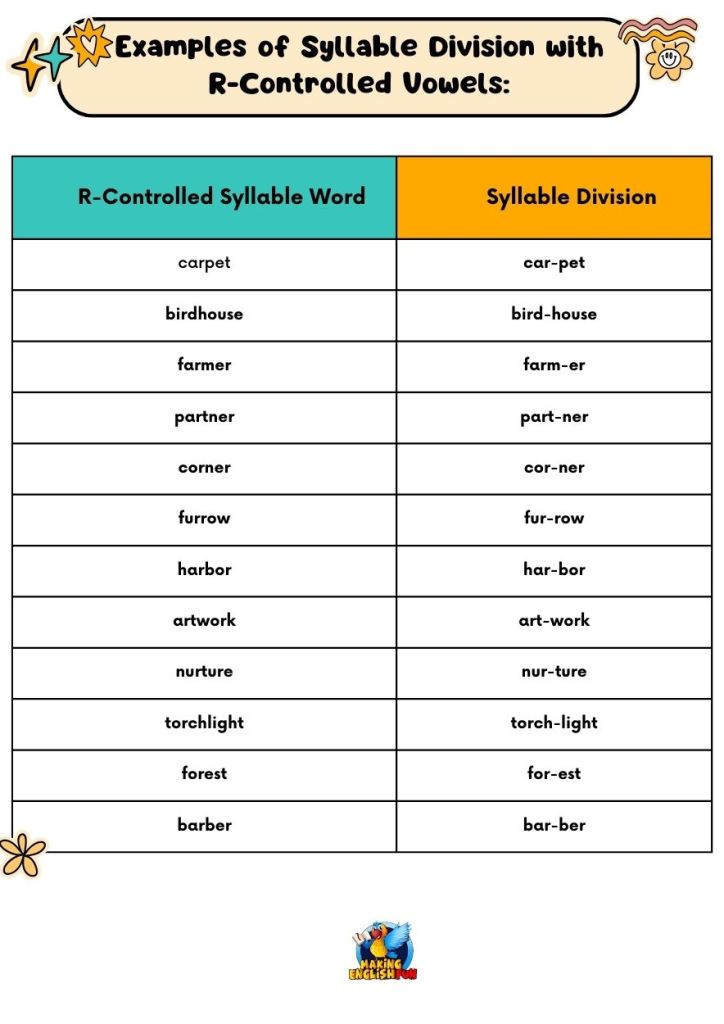
you can get a copy of this table on the link below.
Examples include “car,” “bird,” “fur,” “her,” and “corn.”
In syllable division, the vowel and the ‘r’ usually stay in the same syllable, as in “car-pet” or “bird-song.”
This rule ensures that the unique sound of the r-controlled vowel is not disrupted.
The ‘r’ significantly alters the sound of the vowel preceding it, and separating them can change both the sound and even the meaning of the word.
Table of Examples of Syllable Division with R-Controlled Vowels:
| Word | Division |
|---|---|
| carpet | car-pet |
| birdhouse | bird-house |
| farmer | farm-er |
| partner | part-ner |
| corner | cor-ner |
| furrow | fur-row |
| harbor | har-bor |
| artwork | art-work |
| nurture | nur-ture |
| torchlight | torch-light |
| forest | for-est |
| barber | bar-ber |
7. Vowel Digraphs and Diphthongs Rule
Vowel digraphs and diphthongs are key elements in English pronunciation and syllable division.
A vowel digraph consists of two vowels that produce one sound, such as “ea” in “team” or “oo” in “moon.
A diphthong is a complex vowel sound that begins as one vowel and glides into another within the same syllable, like “oi” in “boil” or “ou” in “house.”
In syllable division, vowel digraphs and diphthongs are not split, as separating them would alter their sounds.
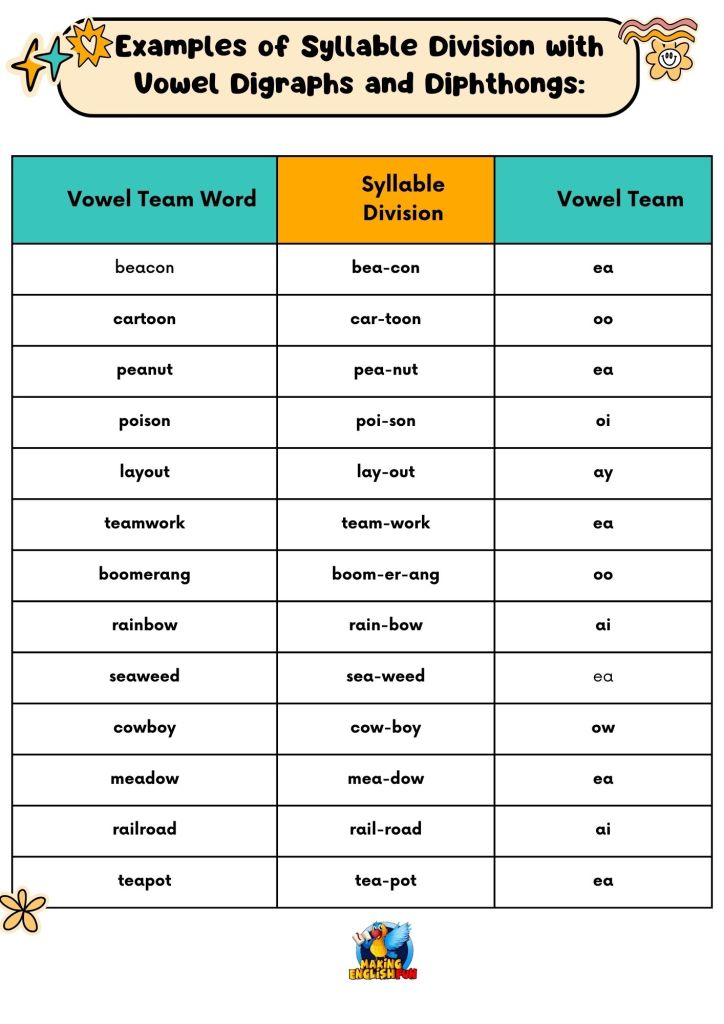
and yes, you can download a copy of this below!
This rule is crucial for maintaining the integrity of the vowel sounds and for ensuring clarity in pronunciation.
It’s especially important in English, as vowel sounds can greatly influence the meaning and understanding of words.
Table of Examples of Syllable Division with Vowel Digraphs and Diphthongs:
| Word | Division | Vowel Team |
|---|---|---|
| beacon | bea-con | ea |
| cartoon | car-toon | oo |
| peanut | pea-nut | ea |
| poison | poi-son | oi |
| layout | lay-out | ay |
| teamwork | team-work | ea |
| boomerang | boom-er-ang | oo |
| rainbow | rain-bow | ai |
| seaweed | sea-weed | ea |
| cowboy | cow-boy | ow |
| meadow | mea-dow | ea |
| railroad | rail-road | ai |
| teapot | tea-pot | ea |
| sneaker | snea-ker | ea |
8. Compound Words Rule
In English, compound words are formed by combining two or more words to create a new word with a distinct meaning.
When dividing syllables in compound words, the division usually occurs between the individual words that make up the compound.
This rule is particularly helpful in understanding the meaning and origin of compound words, as it highlights their composite nature.
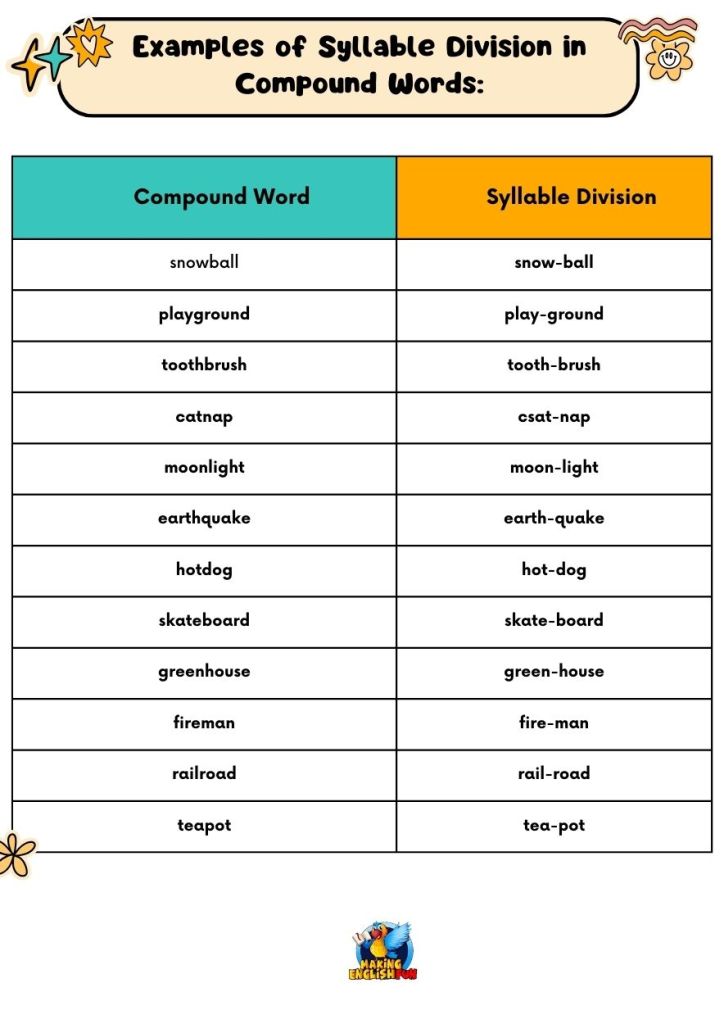
For instance, “snowball” is divided into “snow-ball,” clearly showing its components.
This division is not only important for pronunciation but also for comprehension.
Table of Examples of Syllable Division in Compound Words:
| Compound Word | Division |
|---|---|
| snowball | snow-ball |
| playground | play-ground |
| toothbrush | tooth-brush |
| catnap | cat-nap |
| moonlight | moon-light |
| earthquake | earth-quake |
| hotdog | hot-dog |
| skateboard | skate-board |
| greenhouse | green-house |
| fireman | fire-man |
9. Accented Syllables Rule
The placement of stress or accent in a word can significantly affect syllable division in English.
In words with multiple syllables, the stressed or accented syllable often plays a key role in determining how the word is divided.
In English, the stressed syllable is typically louder, longer, and pronounced with a higher pitch.
This emphasis can influence the division, especially in complex words or words of foreign origin.
The rule of thumb is to keep the accented syllable intact, ensuring that the natural rhythm and pronunciation of the word are preserved.
Understanding accented syllables is particularly important for non-native speakers, even it just an awareness that like all languages, and more than many, English is subject to accents as well!
10. Foreign Words Rule
English is a language rich in words borrowed from other languages.
When it comes to syllable division in foreign words that have been adopted into English, it often retains the syllable division from the original language.
This rule is significant because it respects the phonetic and rhythmic patterns of the original languages, which can be quite different from English.
For instance, a word like “ballet” (from French) or “karaoke” (from Japanese) follows syllable divisions more aligned with their languages of origin as well as pronunciation rules.
Table of Examples of Syllable Division in Foreign Words:
| Foreign Word | Division | Language of Origin |
|---|---|---|
| ballet | bal-let | French |
| karaoke | ka-ra-o-ke | Japanese |
| café | ca-fé | French |
| pizza | piz-za | Italian |
| tsunami | tsu-na-mi | Japanese |
| resume | re-su-me | French |
| machismo | ma-chis-mo | Spanish |
| kindergarten | kin-der-gar-ten | German |
| croissant | crois-sant | French |
| spaghetti | spa-ghet-ti | Italian |
| chimera | chi-me-ra | Greek |
| hacienda | ha-cien-da | Spanish |
11. Homographs Rule
Homographs are words that are spelled the same but have different meanings and sometimes different pronunciations. The syllable division in homographs can change based on their meanings and usage in sentences.
This is particularly unique to English and can be a source of confusion for learners.
Understanding the context and pronunciation of homographs is key to correctly dividing their syllables.
For example, “record” (as in to record something) and “record” (as in a music record) have different stress patterns and thus different syllable divisions: “re-cord” versus “rec-ord.”
Examples of Syllable Division in Homographs:
| Homograph | Division 1 | Division 2 | Meaning 1 | Meaning 2 |
|---|---|---|---|---|
| record | re-cord | re-cord | To document | A music record |
| contest | con-test | con-test | Competition | To dispute |
| incense | in-cense | in-cense | To anger | Aromatic resin |
| present | pre-sent | pre-sent | To introduce | A gift |
| project | pro-ject | pro-ject | Plan | To cast forward |
| refuse | re-fuse | re-fuse | To decline | Waste material |
| permit | per-mit | per-mit | Allowance | To allow |
| object | ob-ject | ob-ject | Thing | To express disagreement |
| produce | pro-duce | pro-duce | To create | Agricultural products |
| rebel | re-bel | re-bel | A person who rebels | To resist authority |
| digest | di-gest | di-gest | To process food | A summary |
| compact | com-pact | com-pact | Agreement | Small and dense |
while the syllables remain the same for these words, mostly, it is the syllable stress that can change their meaning…. but this is a whole other lesson!
Just before we finish up we have some Syllable practice and teaching resources for you here on Making English Fun you can grab from the links below.
- What Are The Six Syllable Types?
- How To Teach Syllables to Children
- The Best Free Online Syllable Games
- Syllables Worksheets – Multi Level.
- R-Controlled Vowel Word Lists
- Vowel-Consonant-e (VCe) Word Lists and Syllables
How to Teach Syllable Division
Teaching syllable division effectively involves a mix of strategies that cater to different learning styles. Here are some tips to make the learning process engaging and effective:
- Start with the Basics: Begin by introducing the concept of what a syllable is – a unit of sound in a word. Use simple examples like “cat” (1 syllable) and “kitten” (2 syllables) to illustrate.
- Clapping Method: Teach students to clap as they say each syllable. This physical activity helps them feel the rhythm of the word and understand syllable division.
- Visual Aids: Use visual aids like diagrams or color-coding to show syllable division in words. This is particularly helpful for visual learners.
- Use Familiar Words: Start with words that students are familiar with, gradually introducing more complex words as they become comfortable with the concept.
- Interactive Games: Incorporate games like syllable sorting, where students group words based on the number of syllables, or syllable matching, where they match syllables to form words.
- Syllable Puzzles: Create puzzles where parts of a word are split into different syllables. Students then have to put them together correctly, enhancing their understanding and recall.
- Teach the Rules: Gradually introduce the rules of syllable division. Avoid overwhelming learners with all the rules at once. Give them time to practice and internalize each rule.
- Practice with Poetry and Music: Use poetry and songs to teach syllables. The rhythm and rhyme of poems and songs naturally emphasize syllabic patterns.
- Incorporate Technology: Utilize educational apps and online resources that offer interactive syllable division activities.
- Encourage Reading Aloud: Reading aloud helps students hear the natural breaks in words and improves their ability to identify syllables.
- Real-Life Application: Encourage students to notice syllables in their everyday environment, like in signs, menus, or books, to reinforce learning.
- Consistent Practice: Regular practice is key. Incorporate syllable division exercises into daily lessons.
Conclusion:
Learning how to recognize syllable division is a practical skill that helps with daily communication. While it is not needed to learn these ten rules all in one go, the first five can really help students with reading and speaking.
After that stage it starts to become second nature.
Hopefully this guide on syllable division and the tables will help you and your children and students achieve this!







